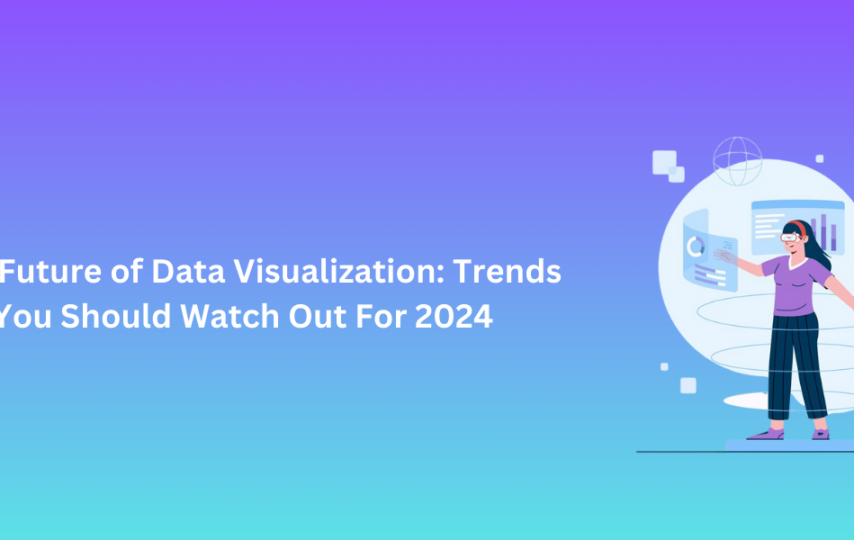As we transition to the next era of data-driven decision, transformational changes occur in the data landscape. With increasing data and complexity, traditional visualization methods need help. Emerging technologies, such as artificial intelligence (AI), machine learning (ML), and augmented reality (AR), offer a new wave of real-time data visualization tools that allow us to interpret complex data and transform how we do it basically as we interact with it. We can also outsource Data Visualization Services to experts.
These developments include the integration of AI and ML to create data analytics and provide actionable insights, the increasing importance of realtime information, and methodologies extensive use of immersive and interactive images to analyze and understand the data through its ability.
What is data visualization?
Data visualization is when data is analyzed and displayed in charts, maps, diagrams, etc., enabling the human brain to receive and grasp data much better than unformatted data. Its primary function is to allow fast and efficient access to the patterns, variations, and fluctuations within big data sets. Terms such as visualization Data display and statistical visualization are often used interchangeably with data visualization.
As an important step in the data science process, data visualization follows the collection, processing, and modeling of data so that findings can be concluded. It also plays an important role in the design of data presentations, focusing on identifying, organizing, and effectively distributing information.
Top Trends of Data Visualization Watch Out for 2024
Technological advancements and changing business needs drive it. The field of data visualization is therefore, evolving rapidly. Key trends that will change the way we view data in 2024 include:
1. Impact of AI in Data Visualization:
The future of data visualization until 2024 will involve using artificial intelligence in data visualization tools such as AI automatic data analysis and generating complex data visualization.
To businesses, inexpensive trends can be uncovered here; thus, no technical knowledge is required in this case. These tools can take in large volumes of data within seconds, analyze them, and suggest the best ways of presenting the information within the chosen formats.
2. Realistic and interactive visualization:
Virtual and augmented reality are the logical continuation of work on interactivity in data visualization. These technologies allow users to navigate through the datasets presented virtually, helping them gain deeper insights into complex datasets. Interactive dashboards will become even more advanced, enabling users to manage and explore real-time data situations.
3. Real-Time Data Visualization:
This is because there is always a demand for data tools that show live data streams, as the market needs real-time decision-making. Live data reporting and representation will be helpful in the health, business, fiscal, and commercial sectors, where timely insights matter. This trend will lead to greater adoption of real-time dashboards, which provide up-to-date information to make faster, more informed decisions.
4. Storytelling with Data:
In 2024, storytelling with data will become more complex. This approach enables users to create meaningful stories that transform raw data into compelling stories. It helps communicate complex perspectives more effectively. This is especially the case in B2B situations because proper communication is key to making decisions in each sale.
5. Renewed interest in special-purpose data visualization:
There will be a higher interest in the special-purpose data visualization solution that meets the company’s requirements. Companies say they want more capacity and elasticity in the way they handle the data, and a custom solution can give them more control over their visualization tools. This trend reflects the need for a personalized experience that can adapt to a company’s growth and unique challenges.
6. Advanced visualization techniques:
As data sets become more complex, advanced visualization techniques such as heat maps will become more prominent. Network diagrams and tree maps help experts explore multidimensional data and discover hidden relationships. These techniques provide a more nuanced understanding of data that traditional visualizations cannot capture.
7. Ethical data visualization:
Businesses should follow ethical data visualization practices. As the world becomes conscious of data privacy issues, businesses will espouse proper tools and methods as the year 2024 approaches to portray compliance with the rules of the display to reflect the transparency and accuracy of their data.
8. DAAS Data as a Service (DAAS):
New DAAS Data as a Service will attract more attention year by year. DVaaS Data Visualization as a Service (DVaaS): Soon, more focus will be paid to DVaaS Data Visualization as a Service. Get access to professional visualization utilities with any business plan. This model is well worth the price. This makes it a good prospect for SMEs who could benefit from the capability to display such things without the expensive initial outlay.
9. Visualizing Collaboration:
In 2024, collaboration will be a crucial focus. Tools designed to facilitate teamwork and sharing perspectives exist. Features like real-time collaboration shared dashboards, and integrations with communication platforms help the team work together more effectively. This will speed up decision-making and strengthen consistency between agencies.
10. Sustainable Data Visualization Practices:
As sustainability becomes a global priority, data visualization practices will evolve to support environmental goals. This includes adopting energy-efficient data centers and cloud solutions that reduce the carbon footprint of data processing and visualization, aligning with corporate sustainability initiatives.
These trends highlight the growing role of technology and ethics in shaping the future of data visualization, ensuring that businesses can interpret data in more dynamic, accessible, and responsible ways.
Data Democratization and Self-Service Tools
The democratization of data has become a key focus. Because various organizations try to make information more accessible to all departments, no-code, and low-code platforms have brought this change. More importantly, it allows people not very professional in technology to design data visuals and reports. The complete exclusion of current-tapped IT professionals or data professionals from the workflow. These platforms enable employees to access information from their different positions. We offer Data Visualisation Services to help you stay open and make informed decisions in real-time. Sharing information empowers the organization to use data at all organizational levels proactively. It allows users to manage datasets.
Explore different perspectives and even create custom dashboards. Users can now create detailed reports and analytics tailored to their needs without advanced technical knowledge. The benefits of this trend are significant. First, it will accelerate the data analysis by removing the bottleneck of relying on technical teams to process and visualize data. Employees from every department, Be it marketing, sales, finance, or operations. Quick access to relevant information and creating actionable insights help businesses respond more quickly to market or internal needs changes. This agility is especially valuable in a rapidly changing industry. Where timely decision-making can create a competitive advantage. Additionally, democratizing data reduces the burden on IT and data teams.
Conclusion
These innovations include AI-powered insights, immersive AR/VR experiences, real-time data processing, and the increasing democratization of data tools. It improves how businesses engage with data, increases the speed of decision-making, and improves accuracy. In addition, the focus is on data storytelling. Ethical visualization practices and sustainable approaches will change how companies Build trust and communicate insights effectively. Embracing these trends will be necessary for businesses seeking a competitive advantage and fostering a data-driven culture. Organizations can remain agile by using advanced visualization techniques and providing teams with self-service tools. Make more informed decisions and unlock the full potential of data in 2024 and beyond.







